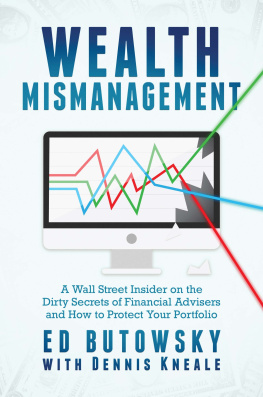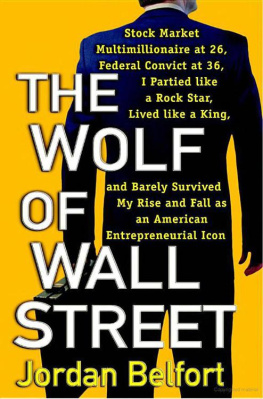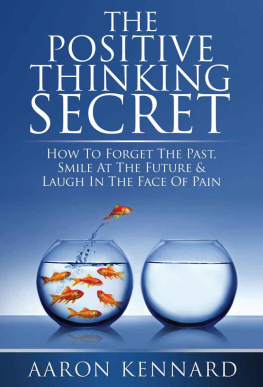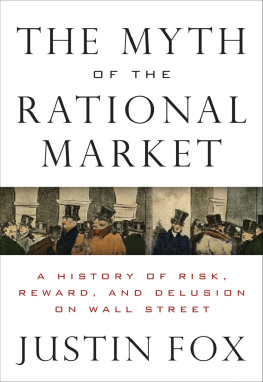Aaron Brown - Red-Blooded Risk: The Secret History of Wall Street
Here you can read online Aaron Brown - Red-Blooded Risk: The Secret History of Wall Street full text of the book (entire story) in english for free. Download pdf and epub, get meaning, cover and reviews about this ebook. year: 2011, publisher: Wiley, genre: Romance novel. Description of the work, (preface) as well as reviews are available. Best literature library LitArk.com created for fans of good reading and offers a wide selection of genres:
Romance novel
Science fiction
Adventure
Detective
Science
History
Home and family
Prose
Art
Politics
Computer
Non-fiction
Religion
Business
Children
Humor
Choose a favorite category and find really read worthwhile books. Enjoy immersion in the world of imagination, feel the emotions of the characters or learn something new for yourself, make an fascinating discovery.

- Book:Red-Blooded Risk: The Secret History of Wall Street
- Author:
- Publisher:Wiley
- Genre:
- Year:2011
- Rating:5 / 5
- Favourites:Add to favourites
- Your mark:
- 100
- 1
- 2
- 3
- 4
- 5
Red-Blooded Risk: The Secret History of Wall Street: summary, description and annotation
We offer to read an annotation, description, summary or preface (depends on what the author of the book "Red-Blooded Risk: The Secret History of Wall Street" wrote himself). If you haven't found the necessary information about the book — write in the comments, we will try to find it.
Red-Blooded Risk: The Secret History of Wall Street — read online for free the complete book (whole text) full work
Below is the text of the book, divided by pages. System saving the place of the last page read, allows you to conveniently read the book "Red-Blooded Risk: The Secret History of Wall Street" online for free, without having to search again every time where you left off. Put a bookmark, and you can go to the page where you finished reading at any time.
Font size:
Interval:
Bookmark:
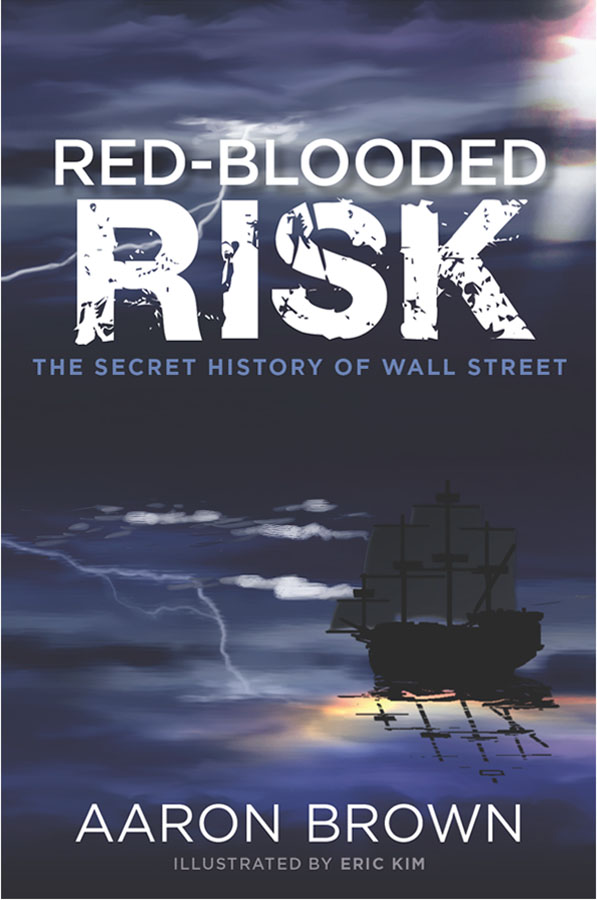
Contents

Copyright 2012 by Aaron Brown. All rights reserved.
Published by John Wiley & Sons, Inc., Hoboken, New Jersey.
Published simultaneously in Canada.
No part of this publication may be reproduced, stored in a retrieval system, or transmitted in any form or by any means, electronic, mechanical, photocopying, recording, scanning, or otherwise, except as permitted under Section 107 or 108 of the 1976 United States Copyright Act, without either the prior written permission of the Publisher, or authorization through payment of the appropriate per-copy fee to the Copyright Clearance Center, Inc., 222 Rosewood Drive, Danvers, MA 01923, (978) 750-8400, fax (978) 646-8600, or on the Web at www.copyright.com . Requests to the Publisher for permission should be addressed to the Permissions Department, John Wiley & Sons, Inc., 111 River Street, Hoboken, NJ 07030, (201) 748-6011, fax (201) 748-6008, or online at www.wiley.com/go/permissions .
Limit of Liability/Disclaimer of Warranty: While the publisher and author have used their best efforts in preparing this book, they make no representations or warranties with respect to the accuracy or completeness of the contents of this book and specifically disclaim any implied warranties of merchantability or fitness for a particular purpose. No warranty may be created or extended by sales representatives or written sales materials. The advice and strategies contained herein may not be suitable for your situation. You should consult with a professional where appropriate. Neither the publisher nor author shall be liable for any loss of profit or any other commercial damages, including but not limited to special, incidental, consequential, or other damages.
For general information on our other products and services or for technical support, please contact our Customer Care Department within the United States at (800) 762-2974, outside the United States at (317) 572-3993 or fax (317) 572-4002.
Wiley also publishes its books in a variety of electronic formats. Some content that appears in print may not be available in electronic books. For more information about Wiley products, visit our web site at www.wiley.com .
ISBN 978-1-118-04386-8 (cloth); 978-1-118-14015-4 (ebk); 978-1-118-14017-8 (ebk); 978-1-118-14016-1 (ebk)
Acknowledgments
The ideas presented in this book are the fruit of an informal collaboration of mathematically inclined researchers who became obsessed with the idea of bettingreal bets for significant stakes versus all comerson the results of their analyses. It is difficult to assign individual credit in a collaboration, and in any case there were too many participants to list here, even if I knew all of them. So I will take the easy way out and dedicate this book to anyone who ever made computations, bet on them, and learned enough from the experience to become successful.
More specifically, I acknowledge the tremendous benefit I have from arguing over these ideas in several places. I thank my colleagues at the various financial institutions I have worked for, and participants in risk conferences over the years, including those run by the Global Association of Risk Professionals, the Professional Risk Managers International Association, Risk magazine, and others. A special mention goes to the triennial conferences on gambling and risk taking produced by the University of Nevada at Reno, which attract a far broader variety of participants than the other conferences.
I also had the benefit of discussing these ideas at online sites, including Wilmott.com , NuclearPhynance.com , QuantNet.com , and TwoPlusTwo.com . And speaking of Internet sites, everyone connected with eRaider.com helped forge my ideas.
It is a little weird to dedicate a book to fictional characters, especially ones the author made up himself. But Red Blood, Blue Blood, Cold Blood, Thin Blood, Hot Blood, Unblooded, and Blood Sucker are composites of real people I have worked with over the years. So I acknowledge here my debt to the dozens of people who provided slices of various characters history and attitudes.
Many people read part or all of the manuscript and sent useful comments. Brandon Adams, Gustavo Bamberger, Bill Benter, John Bogle, Rick Bookstaber, Reuven Brenner, Eugene Christiansen, Emanuel Derman, Art Duquette, Dylan Evans, Doyne Farmer, Justin Fox, Kenneth French, Lisa Goldberg, James Grosjean, Ian Hacking, Michael Heneberry, Carey Hobbs, Craig Howe, James McManus, Michael Maubossin, Nick Maughan, Perry Mehrling, Robert Merton, Joe Nocera, John OBrien, Deborah Pastor, Scott Patterson, William Poundstone, Kevin Rosema, Myron Scholes, James Stoner, Nassim Taleb, Edward Thorp, Whitney Tilson, James Ward, Paul Wilmott, and Bruce Zastera were particularly helpful. The title comes from my daughter, Aviva Pastor. Tiffany Charbonier, Bill Falloon, Stacey Fischkelta, Meg Freeborn, Sharon Polese, and other folks at John Wiley & Sons provided essential feedback and support.
Muhammad Cohen edited every word I wrote, and I rarely overrode his corrections. This book is far more readable for his efforts. Eric Kim provided the drawings. He is a true manga artist, not an illustrator for hire, and the give-and-take we went through added tremendously to the content.
My family, Deborah, Jacob, and Aviva, provided helpful advice and support throughout the process.
CHAPTER 1
What This Book Is and Why You Should Read It
Life is full of choices. At a job interview, you can give short, pleasant answers to questions. Or you can burst into an impassioned rant about how you will add value to the enterprise. You can dress sedately and behave discretely at a party, or go for maximum drama in your clothes and demeanor. In a basketball game you can throw up a quick shot, or pass the ball so the team can work into position for a higher-percentage shot. You can walk on by an interesting-looking stranger, or throw out a remark or a wink. These choices all concern risk.
In the basketball example, you have a coach. When the team is ahead late in the game, the coach will give one kind of advice. On offense, take plenty of time and get a high-percentage shot. On defense, deny the opponents easy shots and do not foul. Why? Because this style of play minimizes the variance of outcome, which is to the advantage of the team in the lead. The trailing team will try to shoot three-point shots quickly and will play aggressively for steals and blocks on defense. They dont mind fouls because those can change the score without running time off the clock. They are trying to maximize variance of outcome.
If youre not familiar with basketball, the same idea applies in virtually every competitive sport. The player or team that is ahead wants to minimize risk, whereas the opposing player or team wants to maximize it. In baseball, a pitcher with a lead throws strikes; when his team is trailing he will work the corners and throw off-speed pitches. In soccer with a lead you try to control the ball and keep your defense back; when behind you attack aggressively. In hockey, the trailing team will sometimes even pull the goalkeeper. In American football, the team with the lead will run the ball up the middle and play prevent defenses, while the other team blitzes and throws long passes.
In the job interview, the short, safe answers are indicated if you think youre likely to get the job and just dont want to blow it. But if youre a long shot to be hired, maybe its time to dust off that rant. Going to an obligatory party for your job, one you know will be boring? Navy suit, say as little as possible and only about the weather, dont drink, and leave early. But if you want to be the life of the party, have a great time, and maybe change your life? Think hot pink. And before you wink at the stranger, ask yourself if youre a bit bored and looking for new adventuresor is your life exciting and complicated enough already and you need peace and quiet more than a new friend?
Font size:
Interval:
Bookmark:
Similar books «Red-Blooded Risk: The Secret History of Wall Street»
Look at similar books to Red-Blooded Risk: The Secret History of Wall Street. We have selected literature similar in name and meaning in the hope of providing readers with more options to find new, interesting, not yet read works.
Discussion, reviews of the book Red-Blooded Risk: The Secret History of Wall Street and just readers' own opinions. Leave your comments, write what you think about the work, its meaning or the main characters. Specify what exactly you liked and what you didn't like, and why you think so.



